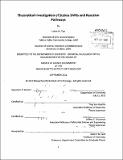Theoretical investigation of Stokes shifts and reaction pathways
Author(s)
Top, Laken M. (Laken Michelle)
DownloadFull printable version (6.269Mb)
Other Contributors
Massachusetts Institute of Technology. Department of Chemistry.
Advisor
Troy Van Voorhis and Jeffrey C. Grossman.
Terms of use
Metadata
Show full item recordAbstract
Solar thermal fuels and fluorescent solar concentrators provide two ways in which the energy from the sun can be harnessed and stored. While much progress has been made in recent years, there is still much more to learn about the way that these applications work and more efficient materials are needed to make this a feasible source of renewable energy. Theoretical chemistry is a powerful tool which can provide insight into the processes involved and the properties of materials, allowing us to predict substances that might improve the efficiency of these devices. In this work, we explore how the delta self-consistent field method performs for the calculation of Stokes shifts for conjugated dyes. We also develop a new reaction path finding method which uses a combination of trigonometric functions and information about the initial and final states in the reaction to generate an approximate path. We show that this path finding method works well for several model systems including a seven atom Lennard-Jones cluster. The ability to calculate excited state properties at a reasonably low cost and to find convergent reaction pathways is extremely beneficial for understanding and improving solar devices.
Description
Thesis (S.M.)--Massachusetts Institute of Technology, Dept. of Chemistry, 2012. Cataloged from PDF version of thesis. Includes bibliographical references (p. 38-40).
Date issued
2012Department
Massachusetts Institute of Technology. Department of ChemistryPublisher
Massachusetts Institute of Technology
Keywords
Chemistry.